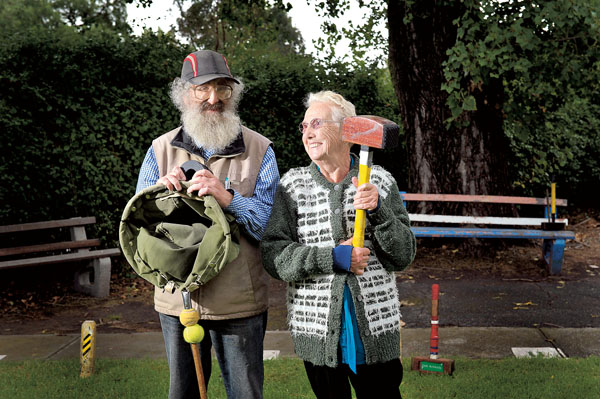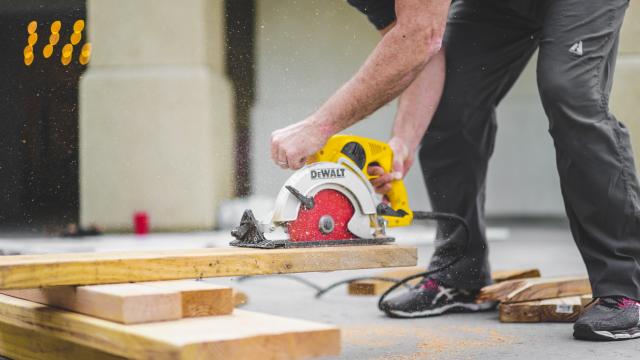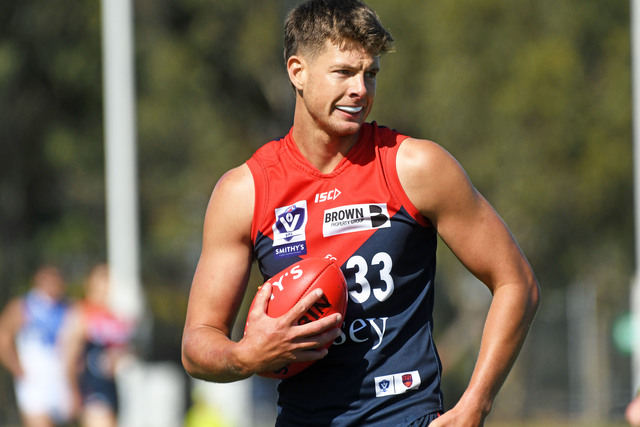Eugene Benson discovers a uniquely Australian sport … and a hole in his jeans.
“WELL, are you going to have a go or what?’’ I’ve been at the Yarraville Trugo Club for less than 10 minutes, watching club members casually practise, when smiling club secretary John McMahon strolls across the lawn and invites me to have a hit.
‘‘Come on, you’ll be right — here, have a go. Use my mallet, it’s got my name on it, see.’’
How could I refuse?
Bending over, first I’m told to look down at a small rubber ring resting roughly between my heels.
I have to hit that rubber ring 27.5 metres behind me through a 1.75-metre gap between small goalposts.
Next I look back through my legs at the goals.
I notice a small hole in my jeans I hadn’t seen before, then that the goalposts are quite a distance away.
And, of course, everything behind me is also upside down.
I wind up and … WHACK!
There it is. I’m playing trugo … poorly. The rubber ring trickles off to the left and doesn’t make the required distance.
If ever there was a truly Australian game it’s trugo.
The game was invented by workers at the Newport railway yards in the 1920s and despite many reports of its demise continues to be played to this day.
Everything needed for the game was in the railway yards.
The rubber rings hit during the game, or ‘donuts’ as they have become known, are buffer washers used on old train carriages.
Mallets or sledgehammers used to whack the donuts were as common as old boots for rail workers and blacksmiths. And then, of course, the playing area is the length and width of a train carriage — a perfect fit.
The sport’s name, it is said, derives from players calling out ‘‘That’s a true go!’’ when a straight shot came off the mallet.
The game’s evolution in the railway yard is a great example of the resourcefulness of the working-class Aussie.
It’s this recent and accessible history the game carries that is part of its appeal to many of its players.
This is certainly the case for McMahon.
Tommy Greaves, a businessman who is credited with bringing the game from the railway yards to the suburbs in the mid-1920s, is acknowledged as the ‘father of trugo’.
McMahon is the game’s modern-day patron and keeper of the trugo flame lit by Greaves.
As a star player and secretary for many years at Yarraville, McMahon takes great pride in the fact that the first organised game of trugo was at his club in 1925.
At 82, he says the game is still flowing through his veins.
‘‘My father played trugo for many years. When he retired he said, ‘Come down and take my place’. I’ve been here ever since.
‘‘They used to meet down at the local pub on a Thursday then come over here to play.
‘‘You just can’t give this up. My children are going to come down here and carry on the game when I stop.’’
Passion for the game has certainly spread to the next generation of McMahons.
A colourful mural depicting a train carriage being hit ‘trugo style’ between a man’s legs is an eye-catching feature of an exterior wall of Yarraville’s Sun Theatre.
It was created by John’s son, artist Peter McMahon.
Trugo participation has certainly fallen away in the past decade.
In 1997 the Victorian Trugo Association had clubs in Ascot Vale, Brunswick, Port Melbourne, Sandridge, South Melbourne, Yarraville, Prahran, Carlton, Coburg, Moonee Ponds, Newport, Preston, Reservoir, Footscray and Williamstown.
Now only Ascot Vale, Brunswick, Port Melbourne, Sandridge, South Melbourne and Yarraville remain.
Yarraville is the sole club in the game’s heartland, the west.
In 2009 the league took a huge blow when Footscray, the second oldest club in the state, folded.
Sunshine resident Ray Schwarze still travels to play at Yarraville but laments the loss of the ‘‘good old days’’.
‘‘We used to have about 60 or 70 people come down on a Tuesday. You’d put your name on the board and sit around having a chat waiting for your turn to play.
‘‘We’d love more members again but you see they go and play the pokies instead now that they’re around.’’
A feature of trugo is its midweek timeframe. Clubs hold practice sessions on Tuesdays then compete on Thursdays.
The top scorers on Tuesday are selected to represent the club on Thursday. The rest come along to support, run the barbecue and offer advice from the sidelines.
In this respect the game mimics the much-vaunted Australian ethic of a ‘fair go’. Players aren’t picked on reputation or former glories.
The heroes of trugo aren’t muscle-bound alpha males either.
In fact it’s more likely they’ve seen better days. They could even carry a limp or a bit too much weight.
It’s one of the few sports men and women play alongside each other and a good eye and sound technique prevail over outright athleticism and strength.
After a three-year hiatus the Ascot Vale Trugo Club is returning to competition this year.
Ascot Vale president Michael Greenway says although in recent years trugo has been characterised as a ‘‘dying game’’ with an ageing player base and dwindling interest, the restoration of the Ascot Vale club was a sign of the trend reversing.
‘‘Come and try’’ days held at the club on Australia Day and in February proved successful and weekly training for a new squad is set to start in May.
‘‘We have put all our efforts thus far into restoring the playing surface at Maribyrnong Park with the assistance of Moonee Valley Council.
‘‘Our aim is to field a team in the Victorian Trugo Association competition starting in August.’’
Greenway believes the game’s future relies on its promotion to older people.
‘‘Traditionally, once out of the rail yard, it was played by retired working men. That still has a place.
‘‘There’s not that many things at an older age you can still compete in and be competitive at.
‘‘When you want to look after the health and welfare of the older population, this is a low-impact social exercise that is perfect — it only takes an hour and a half to play so it won’t dominate your life like bowls might.’’
So there I was, looking up at John McMahon, a little embarrassed after a less-than-spectacular first attempt at hitting a rubber donut the length of a train carriage.
‘‘Have another go, keep steady, keep your head down and make sure you swing true,’’ he said.
WHACK!
‘‘That’s the way. That’s a true go!’’







